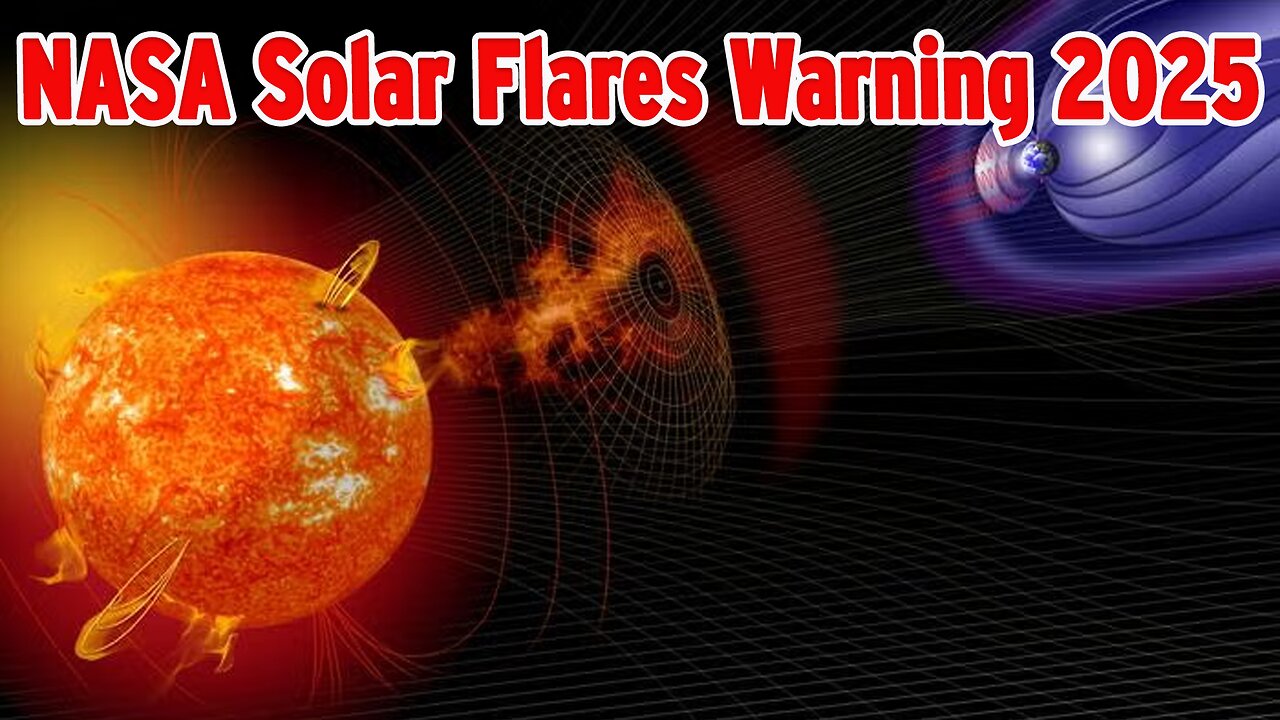Premium Only Content

NASA Solar Flares Warning 2025: Massive X-Class Flare Causes Blackouts | NEWSDRIFT
NASA has just issued a major warning after a powerful X2.7-class solar flare erupted from the sunspot AR4087, causing radio blackouts and threatening power grids, satellites, and GPS systems. In this video, we break down what solar flares are, why NASA is concerned, and how this 2025 solar storm could impact your daily life.
🔥 Trending Topic: NASA Solar Flares 2025
📡 Disruption Reported: Radio blackouts in the Middle East
⚠️ Potential Threats: Communication systems, power outages, satellite damage, GPS failures
🌌 Bonus: Possible auroras visible at lower latitudes
Stay informed and prepared as the sun becomes more active. Watch the full breakdown now and learn how solar activity affects our planet!
#NASASolarFlares #SolarFlare2025 #SpaceWeather #BlackoutAlert #NASAUpdate #SunspotAR4087 #SolarStorm #SolarFlareNews #SpaceNews
Have you ever wondered what would happen if the sun suddenly started disrupting life on Earth? Well, that's not science fiction anymore. A powerful solar flare has just erupted from the surface of the sun, and NASA is issuing serious warnings. This isn't just a typical space update. It's a potential global event, and everyone needs to understand what's going on.
Right now, a particularly active region of the sun, known as sunspot AR4087, is rotating directly into position to face Earth. This region recently unleashed a massive X2.7-class solar flare—the most powerful solar eruption of 2025 so far. This flare was so intense that it caused radio blackouts across parts of the Middle East, disrupting high-frequency communications for around 10 minutes.
So, what exactly is a solar flare, and why should you care? A solar flare is a sudden burst of energy caused by the twisting and snapping of magnetic fields on the surface of the sun. These flares release enormous amounts of radiation. When that radiation is pointed toward Earth, it can cause all kinds of problems—some of them very serious.
NASA and the National Oceanic and Atmospheric Administration, also known as NOAA, have classified this recent flare as an R3-level event. That means it’s strong enough to cause widespread radio communication issues, particularly affecting aviation, maritime operations, and emergency services that rely on high-frequency bands.
But that's not all. These flares can also interfere with power grids here on Earth. The magnetic energy from a solar flare can induce electrical currents in transformers and other equipment, potentially causing overloads and even blackouts. If you’ve ever experienced a city-wide power outage, imagine that happening on a national or global scale.
Satellites are also at risk. The radiation from a solar flare can damage the sensitive electronics aboard satellites, affect GPS signals, and even increase atmospheric drag, which could cause satellites to lose altitude and eventually burn up in the atmosphere.
Right now, the situation is being closely monitored by NASA and NOAA. As sunspot AR4087 continues to rotate and face Earth, there is a real possibility of more flares in the coming days. If another large flare or a coronal mass ejection—what scientists call a CME—hits Earth, we could experience more significant geomagnetic storms.
These storms don’t just affect technology. They can also produce breathtaking auroras. In fact, during strong solar activity, auroras can be visible much farther south than usual. While beautiful, this is also a sign that Earth’s magnetic field is being strongly disturbed.
So, what should you do? First, don’t panic. These events are being tracked in real time by space weather agencies. If any major disruptions are expected, they’ll issue alerts. For now, it’s important to stay informed. Follow updates from NASA and NOAA, especially if you work in industries that rely on satellite communication, aviation, or power systems.
This solar event is a powerful reminder that space weather is not just an abstract concept—it’s real, and it can have a big impact on our daily lives. As the sun enters a more active phase in its 11-year solar cycle, we can expect more of these flares in the months to come.
The keyword trending right now is NASA solar flares, and for good reason. This isn't just about astronomy or science—it’s about preparing for real-world impacts. Whether it’s keeping planes in the sky, maintaining power grids, or protecting the devices we depend on, understanding solar activity is more important than ever.
So keep an eye on the sun, because it's not just a light in the sky. It's a powerful force that shapes our planet, our technology, and our future.
Thanks for listening. Stay safe, stay informed, and don't forget to subscribe for more updates on space, science, and the world we live in.
-
 2:57:02
2:57:02
VapinGamers
7 hours ago $3.46 earnedAltheia - The Wrath of Aferi - Game Review and Playthru - !rumbot !music
22.2K1 -
 2:06:32
2:06:32
TimcastIRL
9 hours agoLeftist NO KINGS Protest Begins, Antifa EMBEDS, Riots & Violence FEARED Nationwide | Timcast IRL
208K170 -
 2:50:31
2:50:31
TheSaltyCracker
9 hours agoHail to the King ReeEEStream 10-17-25
92.1K188 -
 56:04
56:04
Man in America
17 hours agoGold’s OMINOUS Warning: A Global Monetary Reset That’ll BLINDSIDE Americans
58.6K21 -
 1:33:32
1:33:32
Flyover Conservatives
1 day ago3 Winning Mindsets for Building Life-Changing Habits - Clay Clark; Why Employers Are Ditching DEI - Andrew Crapuchettes | FOC Show
49.5K -
 4:04:15
4:04:15
SynthTrax & DJ Cheezus Livestreams
1 day agoFriday Night Synthwave 80s 90s Electronica and more DJ MIX Livestream POST DISCO / FUNK / R & B Edition
51.2K1 -
 51:18
51:18
Degenerate Jay
17 hours ago $3.61 earnedJournalist Claims Batman Is A Fascist Like Donald Trump
45.8K8 -
 1:18:27
1:18:27
Glenn Greenwald
13 hours agoGlenn Takes Your Questions on Major Saudi Arabia Celeb Controversies, Zohran Mamdani and the NYC Debate, Anti-ICE Protests, and More | SYSTEM UPDATE #533
138K37 -
 1:13:26
1:13:26
Tundra Tactical
14 hours ago $5.96 earned🛑{LIVE NOW} Gun Nerd Plays Battlefield 6 Great Tundra Nation Get Together Day 4
33.4K1 -
 12:25:00
12:25:00
GritsGG
13 hours agoRanked Top 70! Most Wins in WORLD! 3734+!
36.6K